

This year, the Computer History Museum honors Robert W. Taylor as a CHM Fellow. Fellows are unique individuals who have made a major difference to computing and to the world around them.
Bob Taylor planned to be a Methodist minister, like his father. He ended up an evangelist for an idea that changed the world: easy-to-use computers that talk to each other. “I was never interested in the computer as a mathematical device, but as a communication device,” Taylor said.
Taylor’s interests – and most of all his unparalleled genius for funding the right people to make them happen – helped develop computer networking, the personal computer, and many of the other technologies that drove the global computer revolution and built the online world.
As we check our pocket computers, aka smartphones, for the dozenth time today for new messages and immerse ourselves in a global cyberspace with billions of citizens from our laptops, it’s hard to see the idea of communicating with computers as radical. But for the computer’s first two decades, it was.
In the 1940s, the same desperate wartime innovation that created the atomic bomb also finalized the development of the general-purpose digital computer. These machines were built mostly with off-the-shelf parts from the enormous and by that time century-old telecommunications industry; relays, vacuum tubes, and diodes.
But the new fragile, room-sized number crunchers were not for communication. In a world that had typewriters and printing presses for text, film and TV for images, and the telegraph, telex, telephone, and radio for messages, who would think of misappropriating the expensive new calculating machines for such purposes? That would be about as sensible as passing notes with a gene-sequencer today. Also, early computers were little more interactive than a washing machine. You gave them a job to do and came back later for the results.
In the 1950s, several men independently came up with the same seemingly crazy dream. Doug Engelbart, Ted Nelson, J.C.R. Licklider, and a few others began to imagine the computer as the ultimate tool for creating, storing, and navigating knowledge.
Even then, these men could see the start of the exponential drop in the cost of processing power and memory that was later canonized as Moore’s Law, and that could one day make the idea of computers for everyday communication practical. But beyond cost, there were two huge things that needed to change for computers to become communication hubs. First, they needed to get interactive, responding instantly to user’s commands rather than spitting back results to a pre-assigned problem minutes or hours later. Second, they needed to get connected – first to multiple users, and then perhaps to each other.
The visionary thinker J.C.R. Licklider helped launch some of the first interactive computer systems with multiple users (timesharing). He laid out his long-term vision in a seminal 1960 paper, “Man-Computer Symbiosis.”
When a young Bob Taylor working on his Masters degree in psychoacoustics came across that work, he says:
It had particular resonance because of Taylor’s recent experience trying to use computers to do calculations for his thesis. When he realized that he would have to laboriously key-punch holes in a stack of cards, leave them and come back later for the results, he recalls:
Licklider went on to run ARPA’s Information Processing Techniques Office (IPTO), charged with funding a broad range of cutting-edge research in computing. By that time Taylor had become a program manager at NASA, and Licklider ended up indirectly recruiting him.
Soon Licklider left ARPA, and he and the other computer communication pioneers concentrated on specific aspects of the vision. Taylor became the money man for this revolution in the making. He had a huge, raw talent for a very particular trade: funding the right people. We don’t tend to associate the word “prodigy” with program officers in funding institutions. But by his late 20s, Taylor was making the grants for three areas at NASA, one of which he’d thought up himself. By his early 30s, when Licklider had installed him as his successor overseeing ARPA’s powerful Information Processing Techniques Office, he was controlling $18 million dollars, or around $110 million annually in today’s money.
At NASA and later ARPA Taylor funded Doug Engelbart, inventor of the mouse and co-inventor of many of the aspects of computing we take for granted today, from hypertext links, to online collaboration, to word processing, to multiple windows. He encouraged and paid for Engelbart and his lab to do the so-called “mother of all demos” in 1968, demonstrating all those features and more to an astonished audience.
Video: Excerpt from Engelbart’s 1968 “Mother of All Demos”
But Taylor wasn’t just a quiet presence behind the scenes writing checks. He knew how much power he had, and wasn’t afraid to use it. When he wanted to recruit a reluctant Larry Roberts to program-manage the creation of the world’s first general-purpose computer network, the ARPAnet, he had his boss mention to Robert’s employer, Lincoln Laboratory, that it was: “… in Larry’s best interest and Lincoln Lab’s best interest if Larry Roberts would come and take this job.”
Taylor and Roberts quickly chose three centers to create critical parts of the system; Bolt, Beranak and Newman in Boston, UCLA, and SRI in Silicon Valley. The system was running by the end of 1969, and between then and a year later the number of users on packet-switched, general-purpose computer networks went from zero, to two, to over a hundred. Their number kept climbing an exponential curve that tops two billion today.
Within months another Taylor and ARPA-funded computer network went live; ALOHAnet in Hawaii. Unlike the ARPAnet, this one was wireless – and the direct ancestor of the digital data networks that surround us like an invisible umbilical cord today, from mobile phones to Wi-Fi.
By this time he and his mentor Licklider co-authored the influential paper “The Computer as a Communication[s] Device.” Taylor was developing his own feel for where he wanted the newly talkative computers and networks to go.

Norm Abramson started ALOHAnet at the University of Hawaii in the early 1970s. The first packet-switched wireless digital network, it inspired Ethernet and is an ancestor of GSM, Wi-Fi, 3G and Bluetooth.
In 1970, he left ARPA and moved to the graphics “Center of Excellence” he had funded and helped create at the University of Utah, with graphics pioneer Ivan Sutherland a leading force. Utah pioneered many of the basic foundations of computer graphics.
But soon Taylor made a transition from funder to hands-on manager; he was recruited as founder of the Xerox PARC Computer Systems Laboratory. Xerox wanted to build a research lab to rival AT&T’s famed Bell Labs, and their budget was impressive even to ARPA-honed sensibilities. Suddenly, all the years of funding projects to make computers communicate came together.
Taylor went out and aggressively recruited the very cream of the crop of researchers he’d cultivated for support at institutions scattered across the country. Many came from Doug Engelbart’s pioneering lab at SRI. Within three years this unruly brigade of geniuses integrated or invented the set of features so familiar on our Mac and Windows machines today, and put them all together in the Alto system – the “office of the future.” These include windowing, the graphical user interface, the mouse, email, Ethernet, connection to an internet, desktop publishing, the direct ancestor of Microsoft Word, and laser printing.
But even the Alto was not the most prescient vision within PARC. Counterculture icon and online community pioneer Stewart Brand wrote a watershed Rolling Stone article in 1972 that among other wonders celebrated PARC researcher Alan Kay’s vision of the DynaBook, essentially a cross between wirelessly networked modern laptops and tablets. Kay was in a different group from Taylor’s, but his evangelism for portable computing oozed over departmental lines. With photos by Annie Leibowitz, the article established the cool factor of PARC’s whiz kids and their vision for the future. Brand dubbed Taylor “the chief marble collector”, meaning that he had assembled nearly all the very best and brightest computer visionaries of the time.
Within PARC, people knew an affordable DynaBook was still many years away. The NoteTaker portable computer was an attempt to realize as many of its goals as possible with late 1970s technology. But the path was clear.
Video: Advertisement for the Xerox Alto, 1979
Warm, sarcastic and direct, with a wicked sense of humor, Taylor could be a wonderful companion or a formidable enemy. As a manager he was both loved and feared. He was a big believer in frequent celebrations for team-building. For instance, weekly tea time, and water balloon slingshot contests and other whimsical games as part of the “SRC Olympics.” But he was also ruthless in his efforts to select – and maintain – the very best. He regularly let go the bottom performing 25% of his employees, based on confidential evaluations of each other. He felt that:
One of the best was the young Bob Metcalfe. Another ARPA alum, Metcalfe went off to Hawaii to study a project funded by Taylor in this ARPA days, Norm Abramson’s ALOHANET. He imaginatively transferred the core principles of that wireless network to wires, and the result was the local net that connected the Altos to their laser printers and beyond – Ethernet.
Video: Advertisement for Ethernet
That research quickly led to connecting Ethernet to other kinds of networks, a process known as “internetting.” The standard was called PUP, for “PARC Universal Packet.” By 1975 over 5000 Alto users were connected to an experimental PUP internet that included the White House. Though hampered by Xerox corporate secrecy, this work fed into the larger research in internetting that produced the ARPA-backed Internet protocols we use today.

The costly Prestel British videotex system had only modest success. It offered a full range of services but flourished largely in specialized markets like the travel industry.
Some of the seeds planted by Taylor and his mentor J.C.R. Licklider sprouted far from the source. Around 1970 an engineer at the British Post Office, Sam Fedida, read their article “The Computer as a Communication Device.” Inspired, he invented Videotex, the first online system for consumers. A set-top box let you use ordinary TV sets as monitors. While the British flavor of Videotex, Prestel, was only a modest success, a French variant that attracted users by offering a free terminal called a Minitel became by far the biggest “web” before the Web, with six million users by 1984. Both Prestel and Minitel offered many of the features we’re familiar with on the Web today, from shopping to travel reservations to chat and online journalism.
Xerox famously failed to successfully market much of the computing wizardry it had paid for. The exception was the laser printer, whose sales alone recouped the total investment in PARC several times over. But most of the other features, from Ethernet and PUP to the graphical user interface, were made famous under names like Apple, and 3Com, and Adobe, and Sun, and Microsoft. Taylor and others fought bitterly with management about this lack of follow through. He recalled a particularly low moment:
Frustrated, he quit and went on to build his own research laboratory at DEC, where his group and another built the first truly dominant search engine, AltaVista. They also created an early e-book reader among other innovations. He retired in 1996.
As I discussed in a previous blog post, last Fall there was quite a kerfuffle over who “really” created the Internet. It sprung from an article in the Wall Street Journal claiming that private industry deserves the credit. If anybody truly knows the peculiar terrain at the intersection of government, private industry, and academia where much of the online world was born, it’s one of the men who helped clear and plant it – Bob Taylor.
Today, Taylor grows tomatoes at his home in the hills overlooking Silicon Valley as a serious hobby. His annual tomato fest is a chance to reconnect with old friends and colleagues. Some of them live in these same steep, gorgeous hills, which were a birthplace of the 1960s counterculture from Ken Kesey and the Merry Pranksters, to early pioneers of high-potency seedless marijuana, to the bearded hippie hackers who staffed PARC, and Stanford’s Artificial Intelligence Laboratory, and SRI. For a man who hand-picked and carefully cultivated several generations of some of the most important geniuses behind the computer and networking revolutions, tomatoes are perhaps less likely to rebel, or talk back. But he’s no less demanding of perfection.